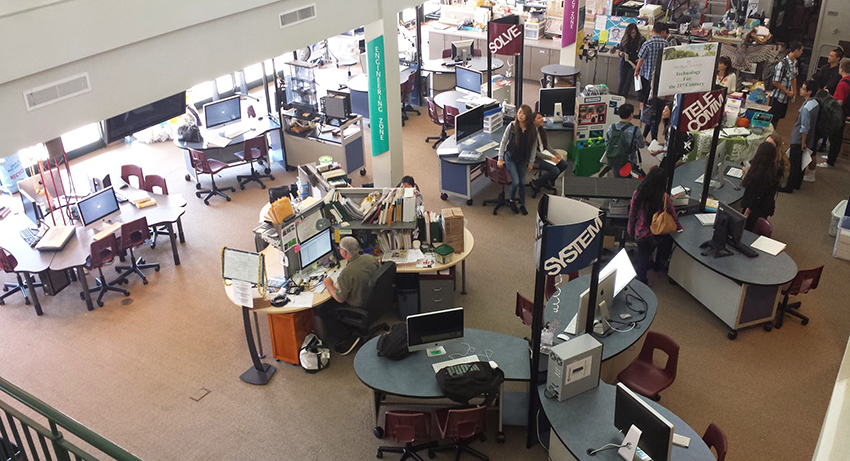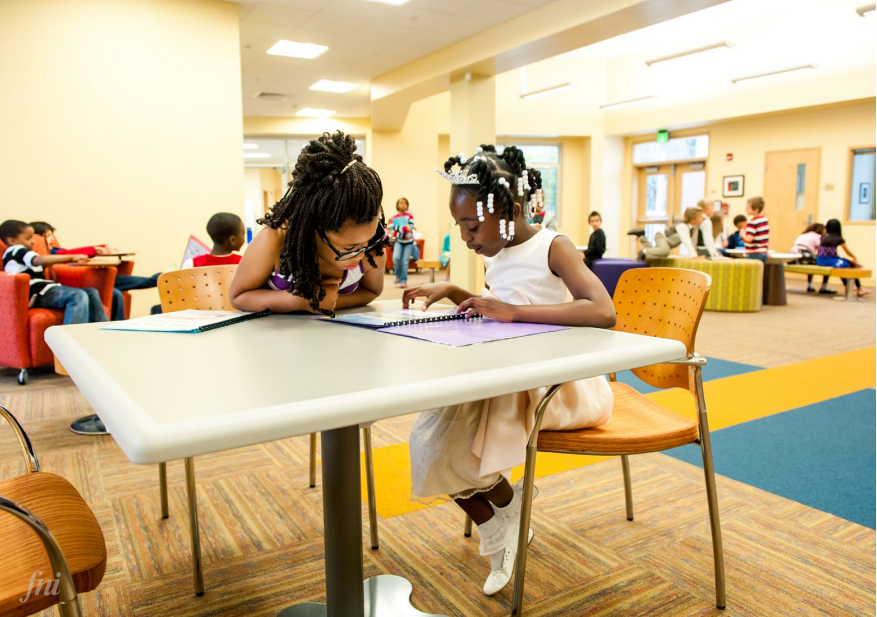
Download a PDF of this blog HERE
Dear President Biden, Secretary Cardona and First Lady Dr. Biden
51 Million Children Need Your Help

And they need it now. Our schools are in trouble. Reopening them is important, but it won’t change the fact that they are no longer capable of fully meeting our children’s social, emotional, physical, and academic needs. The school buildings in which our students learn are educationally obsolete and have been so for at least 20 years. Today, the United States has over $2 trillion of net worth tied up in obsolete school facilities—all of which is at risk because of functional obsolescence, age, and lack of adequate maintenance. i
Staying with the classroom-based school paradigm could permanently destroy our chances of rebuilding our economy and restoring our shrinking middle class to its glory days. The classroom is a relic, left over from the Industrial Revolution, which required a large workforce with very basic skills. Classroom-based education lags far behind when measured against its ability to deliver the creative and agile workforce that the 21st century demands. This is already evidenced by our nation’s shortage of high-tech and other skilled workers—a trend that is projected to grow in coming years. ii
President Biden, you have repeatedly stressed the importance of rebuilding America’s crumbling infrastructure, and there can be few priorities more vital than the restoration of our desperately outdated school infrastructure. In short, it is literally impossible for our nation to “Build Back Better” if we do not include school buildings in the equation.

Today, the United States has over $2 trillion of net worth tied up in obsolete school facilities.
Why Are School Buildings Important?
Let’s start with the obvious reason—we want them to keep children safe, warm, and dry. During the pandemic, safety took precedence, and it became obvious school buildings would not be able to keep children or teachers safe from a highly infectious and dangerous pandemic like COVID-19. School closures across the United States and in 143 countries around the world affected over a billion children who spent months in enforced purgatory at home.
The few schools that stayed open put heavy emphasis on practices like social distancing, mask-wearing, and hygiene. No one is doubting the importance of these measures but, in the process of keeping schools open, the real purpose of our school buildings to provide an inspiring environment in which learning will flourish was forgotten. The pandemic-driven safety focus exacerbated problems already inherent in classroom-based schools that we had only just begun to pay attention to. Under the new model prescribed by COVID-19 restrictions, even the few opportunities previously provided by classrooms for social and emotional development, critical thinking, and problem solving disappeared. The singular obsession with safety may indeed allow students to return in force late in the spring of 2021, but it will do little to improve education.
What is the Answer?
I am proposing the following major initiatives that the federal government can take immediately, in partnership with local communities and public school districts. These initiatives, to be jumpstarted by much-needed investments in building infrastructure, will move the United States toward the modern, equitable, and relevant education system that our children deserve.

In the process of keeping schools open, the real purpose of our school buildings to provide an inspiring environment in which learning will flourish was forgotten.
Establish an Office of Innovative Learning Environments (OILE) within the Department of Education: The current challenges with vaccinating the US population illustrate why a coordinated federal response is essential even when there are local agencies fully capable of actually vaccinating the population. As with the vaccines that are federally controlled but locally distributed, once federal funding is established for school construction (see below), a fair and equitable system needs to be devised to distribute the money. However, OILE would be responsible for far more than simply distributing money. Working closely with national organizations like the Association for Learning Environments iii and the American Institute of Architects iv, OILE would be a research, publication, and policymaking agency that would also serve as a clearinghouse for the latest advancements in the design of learning environments. Some of this research would be funded by OILE in areas that study how school facilities impact student wellbeing and academic achievement.

Some of this research would be funded by OILE in areas that study how school facilities impact student wellbeing and academic achievement.
Create a School Facilities Readiness Database: In order to address any problem, we first need to understand its scope but, at a federal level, we know very little about the condition of our school facilities. One of the biggest and most important tasks that OILE must accomplish is to create a School Facilities Readiness Database. This refers to the readiness of our schools to serve today’s and tomorrow’s education needs. This database will provide a benchmark of exactly where we are with the condition of school buildings in the United States. It will include information about the physical condition of school facilities as well as their educational effectiveness. Such assessments only have value if school building quality can be gauged against local community needs and preferences—their ability to be fully customized to avoid the problem of perpetuating cookie-cutter schools. Fortunately, high quality tools that have been nationally and internationally tested already exist to use for such assessments v. These assessments could be included as part of the qualifications criteria for receiving federal funds. In addition, having this baseline information is also vital for local communities to plan their capital investments wisely. The reliability of data can be guaranteed by establishing a cadre of qualified and trained companies nationally who would be eligible to conduct the assessments. School districts that have recently completed assessments of their school buildings may qualify to include their information into the national database with some refinements to their data for consistency.

This system perpetuates and reinforces the inequities of society where poorer children who need high quality learning environments the most are the least likely to have them.
Fund a National School Construction Program and Create an Equitable Needs-Based Distribution System: Let’s start here with the most important question. How much money will be needed? A reliable estimate will need at least some portion of the school facilities database discussed above to be completed. That information can then be extrapolated to develop a national estimate of needs. In the meantime, we can do some quick math for an order-of-magnitude estimate using some reasonable assumptions. From my own 30-plus years of renovating and rebuilding schools, I can say that a budget of about 30% of the replacement value of an average school will provide enough money to make at least the most important fixes to building systems and leave a sufficient amount for educationally-driven renovations, including new furniture and technology. 30% of $2 trillion is a big chunk of change—$600 billion. However, I’m not suggesting that the federal government foot this entire bill. On average, I think that the federal government should establish a matching grant program where it will match every dollar raised locally for school construction up to a predefined limit based on eligibility criteria. That will cut the price of the program to $300 billion. Assuming that even an accelerated program will take at least 6 years to complete, we are talking about federal subsidies of about $50 billion/year for six years. To put these costs in perspective, the US government will spend, in a little over one year, $802 billion on the critically-needed Payroll Protection Program (PPP) to protect small businesses from collapsing and to prevent catastrophic unemployment during the COVID-19 crisis. Surely, we can come together to accept what amounts to a bill of about 6% (annually) of the PPP for a national school reconstruction program. Unlike PPP which is a short-term fix, the school construction spending will yield social, cultural, health and wellbeing, and economic benefits for the next 20 years at least.

With or without the new imperative for social distancing, the classroom doesn’t work because it cannot meet the need for student autonomy and engagement.
Build Back Better = Equity: And now, we come to one of the most important reasons for the “Build Back Better” School Reconstruction Program, and that is equity. The manner in which school construction is funded in the US is inherently unfair. These monies come directly from local tax dollars which support capital funds that are obtained by passing bond referendums. As expected, more well-to-do communities can afford to pay higher taxes and, therefore, raise more money for construction. This system perpetuates and reinforces the inequities of society where poorer children who need high quality learning environments the most are the least likely to have them. The federal program I have outlined above can tackle this problem by apportioning money based on need. Poorer communities will receive larger subsidies than their wealthier counterparts based on a sliding scale to be established by OILE without increasing the total cost of the school rebuilding program.

That means, schools and school districts applying for federal construction dollars must show how the proposed changes will improve the quality of teaching and learning
Supplement School Construction Funding with Teacher Training Dollars: If a modern school facility is the new “hardware” that tomorrow’s education will demand, then, for it to succeed, it will need a new kind of “software”—a new and more relevant curriculum, a revised schedule that supplants the 50-minute classroom period, and different pedagogical practices in which teachers collaborate to create relevant, real world experiences led by students. These “software” components, starting with teacher professional development, are essential to take advantage of innovatively designed school spaces. Therefore, it makes sense to attach a “software” component to cover these expenses to equal at least 10% of the setaside hardware costs. This will add a modest $5 billion/year in funding to the school infrastructure program.
Tie School Construction Funding to Educational Goals: Federal dollars for school improvement should fall into two categories: 1) Funding for systems improvements such as heating and ventilation, plumbing, electrical, and structural fixes, and 2) Building renovations and modernizations. Every dollar attributed to item #2 should come with an educational justification. That means, schools and school districts applying for federal construction dollars must show how the proposed changes will improve the quality of teaching and learning. For example, a school might show that it needs renovation dollars to convert a section of a school from a typical classroom-and-corridor model into a student-centered learning community. They would have to document how this change will go hand-in-hand with a new curriculum and pedagogy, so that the change actually improves their students’ overall educational experience and not just their learning environment.

The fourth industrial revolution is upon us and it is moving at exponential speed.
Summary: The actual adopted program for school rebuilding may look different than what I have suggested here. The logistics and implementation mechanisms of any school rebuilding program are complex but solvable problems. The key is to use this important time as we emerge from a crisis of historic proportions to reinvent our education system to bring it firmly into modern times. In a piece that I wrote at the height of the pandemic, I said, “Today, the traditional school building is the last domino standing between the past and the future. Knocking it down, metaphorically if not literally, is the critical key to unlocking the incredible creative potential of our children, so that they can go on to build a world far better than the one they are inheriting from us.” vi While there may be a will to do exactly this in communities around the country, the more likely scenario is that, without the kind of federal assistance I have outlined here, our children will remain stuck in a system that fails to deliver the skills and competencies they need to be successful in their lives and careers.
President Biden, in your inaugural address you said, “This is our historic moment of crisis and challenge. We have never, ever, ever failed in America when we have acted together.” You were referring to the COVID-19 crisis and, I maintain that schools must emerge from this crisis stronger than ever before. The time to act together as a nation is now. The Fourth Industrial Revolution is already upon us, and it is moving at exponential speed.

A network of West coast factories built one warship per day—for four years!
Many will wonder if all this is beyond the power or capacity of our federal government to accomplish and wouldn’t it be better to throw money at the problem and privatize this initiative? My answer is that our government is essential in certain sectors and education is one of them. That said, my suggestion is not for the U.S. government to be fully in charge of a national school building program, but rather, as is the case with the national vaccination program, direct the national effort, provide required guidance, and leave the actual execution of the program in the hands of local communities. As to whether or not a national program of this scale is viable, here is the answer—“A single Michigan auto plant figured out how to manufacture a new B-24 bomber plane every hour during World War II, and a network of West Coast factories built one warship per day—for four years.” vii
Driven by President Biden’s vision for equity and the restoration and expansion of our middle class, Dr.Biden’s love of and commitment to the betterment of education, and Secretary Cardona’s impressive record of success, especially with underserved populations, I am optimistic that this message will resonate with you. Please make a new school rebuilding program the showpiece of a new round of infrastructure spending. Design it in a way that it will become the much-needed catalyst to reinvent our antiquated education system.
Respectfully submitted,

Prakash Nair, AIA

Prakash Nair, AIA
Prakash Nair is a world-renowned architect, futurist and the Founding President & CEO of Education Design International. Over the past 18 years, Prakash and his colleagues have worked on the development of innovative schools in 52 countries on six continents and a majority of U.S. states. Prakash has authored three books on school design, two in collaboration with Harvard University. He has won many international awards including the A4LE MacConnell Award, the highest honor worldwide for school design. Prakash also served, for 10 years, as the Director of Operations for a multibillion-dollar school construction program in New York City, the largest of its kind in the world.
Contact: [email protected] M: +1 917.406.3120
Web: EducationDesign.com
Endnotes
i Blueprint for Tomorrow. Redesigning Schools for Student-Centered Learning by Prakash Nair, Harvard Education Press, 2014
ii The Classroom is Obsolete – It’s Time for Something New by Prakash Nair, Education Week, July 2011
https://educationdesign.com/wp-content/uploads/2020/03/The_Classroom_is_Obsolete-Ed-Week.pdf
iii The Association for Learning Environments
https://www.a4le.org/A4LE/
iv Committee on Architects for Education, American Institute of Architects
https://network.aia.org/communities/community-home?CommunityKey=1b63a201-a510-41b7-b801-bca8083b5727
v Education Design International has developed two key online systems whose survey instruments are available as APPS on both the iOS and Android platforms. These APPS first assess the educational efficacy of school buildings and then ensure that renovated facilities are being optimally used. They are available at cost to all public school districts. For more information, contact [email protected] or visit http://edaapp.com/
vi School Buildings – The Last Domino: It’s Time for Learning Spaces to Catch Up by Prakash Nair, Harvard Education Publishing Group, August 6, 2020
https://www.hepg.org/blog/school-buildings-%E2%80%93-the-last-domino-it%E2%80%99s-time-for-l
vii We Look at the Need to Accelerate the U.S. Vaccination Program by David Leonhardt. New York Times, February 17, 2021
https://www.nytimes.com/2021/02/17/briefing/winter-storm-texas-blackout-afghanistan-latifa.html
